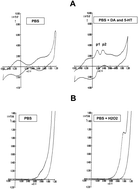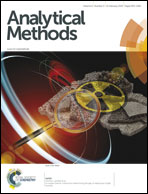Hydrogen peroxide monitored in vivo, in situ and in real time in rat brain, is it a marker of central cholinergic dynamics?
Abstract
Acetylcholine (ACh) is a neurotransmitter acting in both the peripheral and central nervous system (CNS). Various analytical techniques have been adopted for the measurement of ACh in brain. They are complex and “off-line” methods mainly based on separation of ACh and choline and their enzymatic metabolism with detection of the hydrogen peroxide (H2O2) formed. Here we propose a significantly less complex methodology i.e. fast cyclic voltammetry with treated carbon fibre micro-electrodes. It allows monitoring a specific voltammetric oxidation signal [R] in vitro in the presence of H2O2 as well as a selective signal [R] in vivo, in situ and “in real time” following local intrastriatal injection of H2O2 with no change in its oxidation potential. Similarly, intrastriatal injection of acetylcholine (ACh, not electroactive chemical) produces an increase in the size of [R], while neostigmine (ACh esterase inhibitor, not active upon the sensor) significantly decreases [R]. An increase of [R] is also monitored in the striatum of conscious freely moving rats treated with ACh receptor antagonists such as scopolamine or atropine. Thus in vivo modifications of [R] may reflect central cholinergic dynamics and in particular metabolised ACh with generation of H2O2.


 Please wait while we load your content...
Please wait while we load your content...